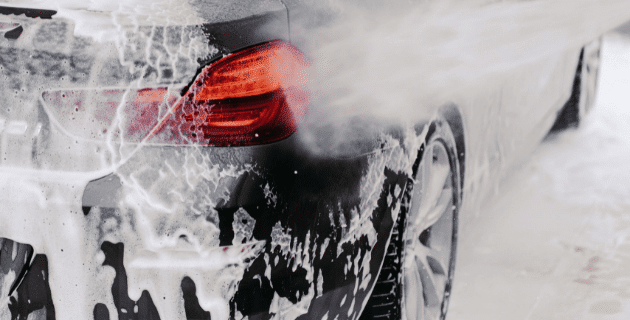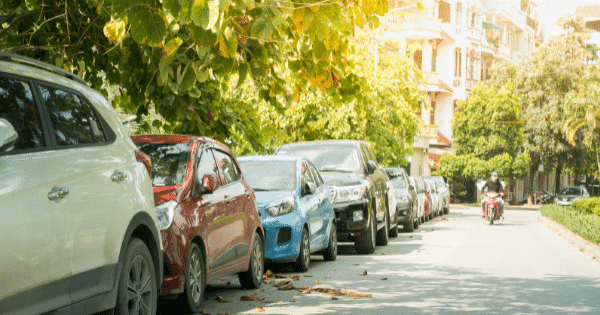
by California Casualty | Auto Insurance Info |
Winter is hard on our cars. Between ice and snow, road salt and dirt, our vehicles often get covered in grime.
But the dirty car you see is just the beginning. Salt, sand, dirt, ice, and rotting leaves can lead to rust which eats away at the exposed metal and causes mechanical issues as well as hurts your car’s resale value.
Keeping your car washed and clean during the cooler months is the best way to protect it from damage. And it will also help keep it from aging. Here’s some more information on why you should keep your vehicle washed this winter.
Winterize your car—before winter.
Before the temperatures dip down, take some time to prepare your car for the winter weather.
-
- Give your car a thorough wash and rinse, paying special attention to areas where salt, sand, and ice can collect such as on the undercarriage and in little crevices.
- Apply a coating of wax, which can help protect against road salt and other debris.
- If you wish, you also can get glass coatings, plastic trim coatings, and paint coatings at your local automotive supply store.
- Switch out cloth floormats for all-weather rubber ones. They will be easier to clean during the winter months.
Make sure you do it on a warm day, 50 degrees or above, or indoors. Cold temperatures make it hard for wax or polish to dry and cure properly.
Wash your car every few weeks.
Your car doesn’t have to be visibly dirty to give it a wash. You should schedule one every couple of weeks throughout the winter.
If washing a car at a car wash…
-
- Choose touchless car washes rather than the ones with the big twirling brushes. They will be gentler to your car’s paint.
- Pay the extra to have your undercarriage sprayed. This is where salt and dirt tend to adhere.
- Make sure your car is dry when you leave. Road salt and dirt stick to wet cars.
If washing a car at home…
-
- Drive your car around the block a few times and crank up the heat to warm it up first.
- Wear waterproof gloves, clothes, and boots.
- Remove snow, ice, and other debris from the car.
- Use warm water to help wash away the initial coat of road grime.
- Use a car wash detergent. (Avoid dish soap which can be hard on your car’s paint.)
- Pay attention to the wheels and undercarriage. These areas are most affected by winter driving.
- If you like, instead of the traditional wash, you could try a “rinse-less” or waterless wash. You may purchase these washes at your local auto supply store. Make sure to have lots of microfiber towels if you choose this option; you will need them.
- When you are finished with the wash and rinse, run the wipers for 10 seconds. This clears away excess water that can freeze later on.
- Open your car doors and dry the rubber weather seals to help prevent them from freezing shut. Do the same around your windows and your fuel door.
Importantly, though, if the temperatures dip below 30 degrees, skip the wash. You will end up with frozen locks and door handles.
Look out for rust.
Rust forms when iron-based metals such as steel are exposed to oxygen. The rust is actually the breakdown of the metal. It’s common for rust to first appear during the winter months. Luckily, you can stop rust in its tracks. It’s important to take care of rust, because it’s considered normal wear and tear, and isn’t usually covered on your car insurance policy.
-
- Check your car for rust each time you wash it. Lower door corners are popular places for rust to appear, as are wheel wells in front and behind tires.
- Identify the kind of rust. See this article in Popular Mechanics on how to fix each kind.
- Surface rust includes scratches and cracks in the paint.
- Scale rust shows up as bubbles in the paint.
- Penetrating rust appears as flakes of metal and holes.
This article is furnished by California Casualty, providing auto and home insurance to educators, law enforcement officers, firefighters, and nurses. Get a quote at 1.866.704.8614 or www.calcas.com.

by California Casualty | Auto Insurance Info |
Have you ever passed up a spot because it required you to parallel park? Don’t worry, you’re not alone. The anxiety/stress that comes with parallel parking is well known. But it doesn’t have to be.
Whether you’re teaching your teen how to parallel park or you simply want to brush up on your technique, here’s a 5-step process to parallel park like a pro.
1. Find a parking spot.
Look for a spot that seems big enough. You will need a space about one and a half times the length of your car. It takes practice to estimate the right size so don’t get discouraged. If you’re not sure if the spot is big enough, pull away and find another.
2. Signal and get in position.
You will be pulling up alongside the car in front of the empty spot. Check your mirrors and your surroundings for other cars and pedestrians. Turn on your right turn signal. Position your car so that its center is even with the other car’s rear bumper. You should be parallel, about 2-3 feet away from the other car.
3. Turn the wheel to the right and reverse.
Sit up tall and turn your body 90 degrees. Again, check your surroundings. When all is clear, put the car in reverse and turn the steering wheel sharply toward the curb so you are approaching at 45-degree angle. Use your car’s backup camera to help guide you. Stop when you see the full front of the car in the back of you in your driver’s side mirror. If your right rear wheel taps the curb, move forward a bit.
4. Turn the wheel in the opposite direction to straighten out.
You can’t continue on that 45-angle without hitting the curb. That means that sometime during your reverse, you will need to stop turning toward the curb and start turning in the other direction. For most cars, you do this when your passenger’s side mirror is in line with the rear bumper of the car in front. As you turn the wheel in the other direction, continue backing up slowly until your car is parallel to the curb.
5. Straighten and align.
You want to make sure you’re between 12 and 18 inches from the curb. Your backup camera will give you an idea of how close you are. You also want to be centered in the spot so that you, and the cars in front and behind you, can get out easily. Creep forward until you are centered. Congratulations! You just parallel parked successfully.
Hi-tech help from your vehicle
When they first came out, backup cameras were revolutionary in helping with parallel parking. The latest technologies are even more so. Parallel parking assist is available on some newer models in a variety of price points. These systems use a camera and sensor-based guidance system that steers the car into the space with little help from the driver.
Simply drive past a parking spot and the car will notify you if it is large enough. Then, select the spot, put it in reverse, engage the parallel parking assist option, and remove your hands from the wheel. Self-parking cars can even do it themselves, and the driver is optional. You can even stand outside the car and use a remote control!
Quick Parallel Parking Safety Tip: Remember to never park in front of a hydrant or fire lane.
Drive safe!
This article is furnished by California Casualty, providing auto and home insurance to educators, law enforcement officers, firefighters, and nurses. Get a quote at 1.866.704.8614 or www.calcas.com.
by California Casualty | Auto Insurance Info |
You’ve been in an accident. Thankfully, you’re not hurt, but unfortunately, you can’t say the same for your vehicle. If the repairs on your car cost more than your vehicle is worth and it needs to be totaled, in the insurance world it is considered a ‘total loss.’
Sounds expensive, right? Don’t worry, your auto insurance policy is designed to protect you in case of an accident. Here are some FAQs to know what to do if this happens to you or a member of your family.
How do you know if your car is totaled?
A vehicle is usually considered a total loss if the damage meets or exceeds around 80% of its value. The insurance company will send an adjuster to look at your car in most cases. The repair shop also may weigh in. The mechanic will examine the structure of your vehicle. He or she will list the repairs needed. Your insurer will check state laws – because some states have rules about how much damage qualifies for a total loss. In all, this assessment will determine the cost to repair your car. If that amount is too much, your vehicle is considered “totaled.”
It is worth noting that you don’t have to be in a car accident to total your vehicle. Your car also could be damaged beyond repair by fire or extreme weather. If a tree falls on your car, that could total it too. The claim process works the same way for those situations.
How much will you get for your car if it is totaled?
If your car is totaled, your insurer will pay you for the actual cash value (ACV) of your car. That amount is determined by your vehicle’s age, condition, mileage, options, and resale value. Since newer vehicles depreciate once you drive them off the lot, the cash value of your car may not be the same as the price you paid—even if the accident occurs soon after you purchased the vehicle.
What if the accident was the other driver’s fault?
If the accident was not your fault, you can file a claim with the other driver’s insurance company. Their policy will pay you using their property damage liability coverage. But what happens If the other driver doesn’t have insurance, or doesn’t have enough insurance to cover damages? Then you will be covered under uninsured/underinsured motorist property damage. These are optional coverages in the majority of states. In some states, you are not allowed to carry collision and UMPD at the same time. Also, sometimes UMPD has a policy maximum or cap on the amount it will pay. If you have UMPD/UIMPD, and it isn’t enough to cover the total cost of your car, your own collision coverage will help.
What if the accident was your fault—or the fault of Mother Nature?
If you caused the accident, and your car is totaled, your insurance company will pay the cash value of your car minus your deductible and any state taxes or fees. When you are at fault, your collision coverage kicks in. Collision pays for totaled cars after colliding with another vehicle, tree, rail or other structure. You have this coverage if you are financing or leasing a vehicle; it’s required.
If Mother Nature caused the damage, comprehensive coverage pays for it. Again, this is coverage that is required if you are financing or leasing a vehicle. Comprehensive covers natural disasters, fires, vandalism, theft, and animals that damage your vehicle. However, if your car was paid off, and you don’t have comprehensive or collision insurance, you would be responsible for the full costs to repair your totaled vehicle.
Your car doesn’t look that bad. How could it be totaled?
You can’t always tell the extent of the damage by looking at a vehicle. For example, a car that sat in flood waters higher than the seat would have extensive flood damage to the engine. Looking at it after it has dried out might not tell you that parts need replacement. In addition,
repairs from collisions can cost more than you think. Finally, your state may have regulations that require vehicles with a certain amount of severe damage to be declared a total loss.
What if you want to keep your car anyway?
We understand that you may have a sentimental attachment to your car. Talk to your claims adjuster to see if you are able to keep it. Your settlement will be less if you decide to do so. In addition, you will have to talk to your insurance agent about the possibility of keeping a totaled vehicle on your policy or if you have to find other insurance. Proceed with caution. A car that has been totaled is usually better off replaced than rebuilt.
What if you haven’t paid off your car yet?
Accidents happen. That’s true whether your car is paid off or you’re still making loan payments. If you total your car and you’re still paying for it, you will continue to be responsible for the amount owed. That’s true even if you’re no longer able to drive the car. The good news is that you can use the money from the cash value of your totaled vehicle to repay the lender.
After you get the insurance check, there may still be an amount owed, and you will be responsible for it. Consider gap insurance also known as loan/lease insurance. This type of insurance covers the difference between the loan or lease payoff and the cash value of your car. It can provide peace of mind should you find yourself in this situation.
What if you totaled a leased car?
Your insurer will send the check for cash value to your lender. You will be responsible for any additional charges. If you still owe but the accident was not your fault, contact the other driver’s insurance company to cover that additional payment. It’s always a good idea to continue to make your lease payments until the insurance company issues the check so that your credit rating doesn’t suffer.
What if your teen totals your car?
In most cases, teen drivers are covered under their parents’ policies. The coverage selected by the policy owner will apply. If you have comprehensive and collision insurance, your teen will have the same deductible that you selected. Your or your son/daughter will pay the deductible and the insurance will cover the remaining cost. If, however, you don’t have comprehensive and collision, you will be responsible for the full amount.
Make sure you add your teen driver to your policy. Some insurers will deny coverage if your son or daughter is in an accident and not on your policy. Others will charge you for back premiums from the time the teen was licensed. National Teen Driver Safety Week is Oct. 17-23, 2021. It’s a good time to talk to your teen about car maintenance tips and distracted driving to help keep them safe on the roads.
What are the steps to take if your car is totaled?
After an accident, totaled vehicles are often sent to the impound lot, or tow yard, which is a holding place until the next step. If declared a total loss, they could be sent on to a salvage auction. Because the car may not be in your possession, you will want to remove all important information right after the accident.
-
- Make sure to clear out your personal belongings. Check all storage areas within your vehicle, including the glove compartment, trunk, and cubbies.
- Get all copies of the key.
- Get the title. If your car is leased, request that the title be sent to your insurance company. If you are not leasing, and you own the car, you can request a copy of the title from the DMV.
- Schedule vehicle pickup or drop-off with your insurer.
- Your adjuster will advise on handing over the title, and the keys if not already with the car.
- Sign the paperwork and receive payment.
This article is furnished by California Casualty, providing auto and home insurance to educators, law enforcement officers, firefighters, and nurses. Get a quote at 1.866.704.8614 or www.calcas.com.

by California Casualty | Auto Insurance Info |
Your son or daughter may have your eyes and your talent for sports. They also likely have your driving habits. Studies have shown that teen drivers often model their driving off of their parents.
Whether that’s good news… or not so good…. here’s a closer look at this phenomenon, and how you can keep your teen safe on the road.
What We Say Vs. What We Do
What parents do behind the wheel has a greater impact than what they say, according to a study by Toyota and the University of Michigan Transportation Research Institute. Researchers surveyed new drivers aged 16-18 and parents of this age group. They found that teens who engage in unsafe driving behaviors, such as cell phone use, often have parents who do the same.
That makes sense because long before your teen started driving, he/she was a passenger in your car. For years, you have been modeling driving habits without realizing it. Therefore, telling your teen not to text when driving – when you do it – can actually suggest that it’s really okay.
Tips for Parents of Teen Drivers
Now that your teen is driving, this is a good time to revisit and possibly revamp your driving habits. Here are seven easy ways that you can set a good example for your young driver.
1. Refresh yourself on the rules of the road.
It’s been a while since you’ve studied for your state driving test. Now might be a good time for a refresh. Pick up your state’s DMV handbook and review the rules. If your teen sees you taking this seriously, he/she will too. Pay special attention to your state’s graduated driver licensing program. States have these laws to ease new drivers into driving with limited hours, limited passengers and other precautions.
2. Put away the phone.
If you’ve ever texted or made a call while driving, you’re not alone. This distracted driving behavior is as common among adults as teens. But cell phone use is as dangerous as driving under the influence. You are just as likely to get into a crash when using a cell phone as when drinking and driving. Teens are frequent texters, and the temptation to do so behind the wheel is great. A study in the Journal of Adolescent Health revealed that nearly 40 percent of teens had texted or emailed while driving in the past 30 days. That’s why it’s important to model behavior where you put your cell phone away. Don’t use it at stop signs or red lights. Consider using your phone’s “do not disturb” setting while driving. That will automatically put it out of commission.
3. Put away the food.
It might be common for you to eat or drink behind the wheel. After all, isn’t that what drive-throughs are for? Yet anything that takes your attention away from the road is a distraction that could cause an accident. Instead of eating while driving, pull over into a parking spot. Then you can really enjoy that hot lunch, coffee or treat with your teen.
4. Watch your speed.
It’s tempting to drive faster when you’re running late. You also may speed when you’re tired after a long day and you just want to get home. However, speeding is never safe and often costly—in terms of tickets and wear-and-tear on your tires. Speeding also uses more gas. Make every effort to drive the speed limit with your teen. Set your car to cruise control. Remember why you are modeling this behavior.
5. Talk to your teen about drinking and driving.
The teenage years are filled with experimentation. Your teen may on occasion try alcohol, even if it’s illegal and you have forbidden it. As we know, drinking and driving are a dangerous combination. About one in four teen car crashes involve driving under the influence, according to the Substance Abuse and Mental Health Services Administration. Talk with your teen about their options should they find themselves in a situation where they – or a friend – have been drinking and is about to get in the driver’s seat. Emphasize that it is never okay to drink and drive and that the consequences could be deadly.
6. Make time to drive with your teen.
Your teen has watched you drive for years. Now it is your turn. Make the time to drive with your teen, in all road conditions. Show them that you trust them behind the wheel. Compliment him/her on safe driving behaviors. The more time you spend in the car with them, the more comfortable you (and they) will be when they are driving on their own.
7. Create a written safety agreement.
Sure, you’ve told your teen a hundred times not to text while driving and to be home by 10 pm. But putting those rules in writing makes them official. A written safety agreement shows in black and white exactly what you expect from your teen. Violations of that agreement could result in loss of driving privileges.
Use the elements of your state’s graduated license program as a basis for the safety agreement. This will likely include limiting the number of passengers in the car with your teen and the times that he/she can be on the road. Make sure you include any other family rules such as the curfew for the car being home, and how you wish your teen to check in with you. In doing so, you are setting up your teen for a lifetime of safe driving.
This article is furnished by California Casualty, providing auto and home insurance to educators, law enforcement officers, firefighters, and nurses. Get a quote at 1.866.704.8614 or www.calcas.com.

by California Casualty | Auto Insurance Info, Safety |
Teenagers and vehicles can be a deadly combination. Motor vehicle accidents are the leading cause of death in teens ages 15-20 in the United States.
It’s a terrifying thought that as a parent you can’t always be there to keep them safe when they are behind the wheel. Give yourself peace of mind by taking steps to educate your teen and give them the proper tools they need before they take off on their own.
This includes taking driver’s safety or education courses, practicing in all driving conditions, knowing what to do in an emergency, talking about the dangers of distracted driving; and most importantly doing your research and purchasing (or letting them purchase) a safe and reliable vehicle.
Now, we know looking for a new car can be stressful, especially with your teen who probably wants new-new and not new-to-them, so we’ve done the research for you.
Here are the best vehicles for teens in 2021 according to IIHS and Consumer Reports.
| Small cars |
Model years |
Price |
| Mazda 3 sedan or hatchback |
2014 or newer; built after October 2013 |
$8,100 |
| Toyota Prius |
2014 or newer; built after November 2013 |
$8,600 |
| Hyundai Elantra GT |
2018 or newer |
$15,200 |
| Subaru Crosstrek |
2017 or newer |
$17,900 |
| Honda Insight |
2019 or newer |
$18,200 |
| Toyota Prius Prime |
2017 or newer |
$18,200 |
| Toyota Corolla hatchback |
2019 or newer |
$18,300 |
| Kia Niro |
2019 |
$18,600 |
| Subaru Impreza sedan and wagon |
2019 |
$19,400 |
| Midsize cars |
Model years |
Price |
| Subaru Outback |
2013 or newer; built after August 2012 |
$8,700 |
| Subaru Legacy |
2013 or newer; built after August 2012 |
$8,800 |
| Mazda 6 |
2014 or newer |
$10,100 |
| Lincoln MKZ |
2013, 2016, 2018 or newer |
$10,300 |
| Honda Accord sedan or coupe |
2013 or newer |
$10,900 |
| Volkswagen Passat |
2016-17 |
$11,400 |
| Toyota Prius v |
2015-18 |
$11,600 |
| Volkswagen Jetta |
2017 |
$12,900 |
| Volvo S60 |
2016, 18 |
$14,100 |
| BMW 3 series |
2017 or newer; built after November 2016; 4-cylinder only |
$17,900 |
| Large cars |
Model years |
Price |
| Ford Taurus |
2014 |
$9,600 |
| Hyundai Genesis |
2016 |
$18,700 |
| Small SUVs |
Model years |
Price |
| Mazda CX-5 |
2014 or newer; built after October 2013 |
$9,300 |
| Nissan Rogue |
2014, 2016-18, 2020 |
$10,100 |
| Subaru Forester |
2016 or newer |
$13,500 |
| Honda CR-V |
2015 or newer |
$14,800 |
| Kia Sportage |
2017, 2018, 2020 |
$14,800 |
| Toyota RAV4 |
2015 or newer; built after November 2014 |
$14,900 |
| Honda HR-V |
2017 or newer; built after March 2016 |
$15,400 |
| Hyundai Kona |
2018 or newer |
$15,800 |
| Buick Encore |
2018-19 |
$16,300 |
| Hyundai Tucson |
2018 or newer |
$16,800 |
| Mazda CX-3 |
2019 or newer |
$17,800 |
| Volvo XC60 |
2017 |
$19,200 |
| Midsize SUVs |
Model years |
Price |
| Chevrolet Equinox |
2017, 2019 |
$13,700 |
| Nissan Murano |
2015 or newer |
$14,800 |
| GMC Terrain |
2017, 2019 |
$15,100 |
| Lexus NX |
2015-16, 2018 or newer |
$16,000 |
| Kia Sorento |
2017-18 |
$16,500 |
| Hyundai Santa Fe |
2017-19; built after March 2016 |
$18,700 |
| Ford Edge |
2018 or newer |
$19,600 |
| Mazda CX-9 |
2017 or newer; built after November 2016 |
$19,600 |
| Audi Q5 |
2016-19 |
$19,800 |
| Minivans |
Model years |
Price |
| Toyota Sienna |
2015-16 |
$13,900 |
| Honda Odyssey |
2016 |
$15,400 |
| Kia Sedona |
2017 |
$15,600 |
Remember, when looking at vehicles talk to your insurance agent to see what will save you the most with your teen on your policy. And don’t forget to look out for recalls or damage from previous owners.
This article is furnished by California Casualty, providing auto and home insurance to educators, law enforcement officers, firefighters, and nurses. California Casualty does not own the data table show above. Get a quote at 1.866.704.8614 or www.calcas.com.

by California Casualty | Auto Insurance Info |
A new driver in the household can really impact your auto insurance rates. This is because teen drivers ages 16 -19 are more likely to be involved in accidents than any other age group. If you’re the parent of a teen who just got their license, learning how you can save on your auto insurance is a necessity.
Here are 7 ways you can control your car insurance premiums and get discounts with a teen driver.
1. Shop for coverage
Whether you stick with your current auto insurance carrier or you plan to shop around, make sure that you go with an insurance company that will quote your new driver for free and let you know upfront any benefits or discounts that you may be eligible for.
2. Enroll them in a driver safety education course
Most insurers will reward teenage drivers who complete a driver’s education or safety course with a discount. By passing the course your teen can prove they have the knowledge and skills behind the wheel to avoid an accident.
3. Take advantage of good student discounts
Good grades don’t only help your teen out in the classroom, they can also qualify for a ‘good student discount’ with your auto insurance provider. Talk to your insurance agent to see how much you can save by turning in your child’s report card.
4. Purchase a reliable vehicle with a good safety rating
We all know that the costs of our vehicles directly influence what we will pay for auto insurance. Before you go car shopping with your teen talk to your insurance agent and see how much it would be to insure a newer car vs. an older car. Don’t forget to ask about any discounts or rewards for safety ratings or features like airbags, anti-lock brakes, seatbelt alarms, and power steering.
5. Limit the miles they drive
Miles driven can also affect the cost of your insurance. This is because the longer you are on the road, the more likely you are to have an accident. So, one of the best ways to avoid a rate increase is to keep mileage to a minimum. Limit your teens driving to work, school, and only in-town functions and you may qualify for low-mileage discounts.
6. Bundle your protection and save
Instead of getting your teen their own suit insurance policy, you can save by adding them to your existing policy. And you can save even more each month with the ‘insurance bundle discount’- when you add your auto insurance policy onto other policies that you have with your carrier, like your homeowner’s insurance or renter’s insurance policy.
7. Drive SAFE!
The best way to save money (and stress) is to teach and emphasize the importance of safe driving. It will not only prevent a costly accident, but it will give you peace of mind, as a parent, that your new driver is doing everything they can to stay safe on the road.
There’s no greater value than knowing your family is properly protected.
This article is furnished by California Casualty, providing auto and home insurance to educators, law enforcement officers, firefighters, and nurses. Get a quote at 1.866.704.8614 or www.calcas.com.





